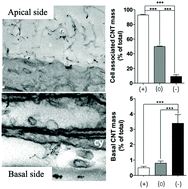Quantification of blood–brain barrier transport and neuronal toxicity of unlabelled multiwalled carbon nanotubes as a function of surface charge†
Abstract
Nanoparticles capable of penetrating the blood–brain barrier (BBB) will greatly advance the delivery of therapies against brain disorders. Carbon nanotubes hold great potential as delivery vehicles due to their high aspect-ratio and cell-penetrating ability. Studies have shown multiwalled carbon nanotubes (MWCNT) cross the BBB, however they have largely relied on labelling methods to track and quantify transport, or on individual electron microscopy images to qualitatively assess transcytosis. Therefore, new direct and quantitative methods, using well-defined and unlabelled MWCNT, are needed to compare BBB translocation of different MWCNT types. Using highly controlled anionic (−), cationic (+) and non-ionic (0) functionalized MWCNT (fMWCNT), we correlate UV-visible spectroscopy with quantitative transmission electron microscopy, quantified from c. 270 endothelial cells, to examine cellular uptake, BBB transport and neurotoxicity of unlabelled fMWCNT. Our results demonstrate that: (i) a large fraction of cationic and non-ionic, but not anionic fMWCNT become trapped at the luminal brain endothelial cell membrane; (ii) despite high cell association, fMWCNT uptake by brain endothelial cells is low (<1.5% ID) and does not correlate with BBB translocation, (iii) anionic fMWCNT have highest transport levels across an in vitro model of the human BBB compared to non-ionic or cationic nanotubes; and (iv) fMWCNT are not toxic to hippocampal neurons at relevant abluminal concentrations; however, fMWCNT charge has an effect on carbon nanotube neurotoxicity at higher fMWCNT concentrations. This quantitative combination of microscopy and spectroscopy, with cellular assays, provides a crucial strategy to predict brain penetration efficiency and neurotoxicity of unlabelled MWCNT and other nanoparticle technologies relevant to human health.



 Please wait while we load your content...
Please wait while we load your content...